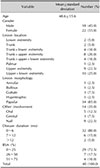1. Boyd AS, Neldner KH. Lichen planus. J Am Acad Dermatol. 1991; 25:593–619.


2. Lehman JS, Tollefson MM, Gibson LE. Lichen planus. Int J Dermatol. 2009; 48:682–694.


3. Marshman G. Lichen planus. Australas J Dermatol. 1998; 39:1–11.


4. Shiohara T, Kano Y. Lichen planus and lichenoid dermatoses. In : Bolognia J, Jorizzo JL, Schaffer JV, editors. Dermatology. 3rd ed. Philadelphia, PA: Elsevier Saunders;2012.
5. Daoud MS, Pittelkow MR. Lichen planus. In : Freedberg IM, Eisen AZ, Wolf K, Austen KF, Goldsmith LA, Katz SI, editors. Fitzpatrick's dermatology in general medicine. 7th ed. New York: McGraw-Hill;1999. p. 561–577.
6. Gorouhi F, Davari P, Fazel N. Cutaneous and mucosal lichen planus: a comprehensive review of clinical subtypes, risk factors, diagnosis, and prognosis. ScientificWorldJournal. 2014; 2014:742826.

7. James WD, Berger TG, Elston DM. Lichen planus and related condition. In : James WD, Elston DM, Berger TG, Andrews GC, editors. Andrews' diseases of the skin: clinical dermatology. 11th ed. Philadelphia, PA: Elsevier Saunders;2011.
8. Roopashree MR, Gondhalekar RV, Shashikanth MC, George J, Thippeswamy SH, Shukla A. Pathogenesis of oral lichen planus--a review. J Oral Pathol Med. 2010; 39:729–734.

9. Öztürk MO, Uluşahin NA. Ruh Sağlığı ve Bozuklukları. Ankara: Hekimler Yayğn Birliği;1994.
10. Tamam L, Zeren T. Depresyonda serotonerjik düzenekler. Klinik Psikiyatri Dergisi. 2002; 5:11–18.
11. Müller N. Immunology of major depression. Neuroimmunomodulation. 2014; 21:123–130.


12. Leonard BE. The HPA and immune axes in stress: the involvement of the serotonergic system. Eur Psychiatry. 2005; 20:Suppl 3. S302–S306.

13. Rödström PO, Jontell M, Hakeberg M, Berggren U, Lindstedt G. Erosive oral lichen planus and salivary cortisol. J Oral Pathol Med. 2001; 30:257–263.


14. Huang J, Li G, Xiang J, Yin D, Chi R. Immunohistochemical study of serotonin in lesions of psoriasis. Int J Dermatol. 2004; 43:408–411.


15. Huang J, Li G, Xiang J, Yin D, Chi R. Immunohistochemical study of serotonin in lesions of chronic eczema. Int J Dermatol. 2004; 43:723–726.


16. Akay A, Pekcanlar A, Bozdag KE, Altintas L, Karaman A. Assessment of depression in subjects with psoriasis vulgaris and lichen planus. J Eur Acad Dermatol Venereol. 2002; 16:347–352.


17. Allen CM, Beck FM, Rossie KM, Kaul TJ. Relation of stress and anxiety to oral lichen planus. Oral Surg Oral Med Oral Pathol. 1986; 61:44–46.


18. Bergdahl J, Ostman PO, Anneroth G, Perris H, Skoglund A. Psychologic aspects of patients with oral lichenoid reactions. Acta Odontol Scand. 1995; 53:236–241.


19. Chaudhary S. Psychosocial stressors in oral lichen planus. Aust Dent J. 2004; 49:192–195.


20. Ivanovski K, Nakova M, Warburton G, Pesevska S, Filipovska A, Nares S, et al. Psychological profile in oral lichen planus. J Clin Periodontol. 2005; 32:1034–1040.


21. Koray M, Dülger O, Ak G, Horasanli S, Uçok A, Tanyeri H, et al. The evaluation of anxiety and salivary cortisol levels in patients with oral lichen planus. Oral Dis. 2003; 9:298–301.


22. Lundqvist EN, Wahlin YB, Bergdahl M, Bergdahl J. Psychological health in patients with genital and oral erosive lichen planus. J Eur Acad Dermatol Venereol. 2006; 20:661–666.


23. Rojo-Moreno JL, Bagán JV, Rojo-Moreno J, Donat JS, Milián MA, Jiménez Y. Psychologic factors and oral lichen planus. A psychometric evaluation of 100 cases. Oral Surg Oral Med Oral Pathol Oral Radiol Endod. 1998; 86:687–691.

24. Soto Araya M, Rojas Alcayaga G, Esguep A. Association between psychological disorders and the presence of Oral lichen planus, Burning mouth syndrome and Recurrent aphthous stomatitis. Med Oral. 2004; 9:1–7.

25. Vallejo MJ, Huerta G, Cerero R, Seoane JM. Anxiety and depression as risk factors for oral lichen planus. Dermatology. 2001; 203:303–307.


26. El-Nour H, Lundeberg L, Abdel-Magid N, Lonne-Rahm SB, Azmitia EC, Nordlind K. Serotonergic mechanisms in human allergic contact dermatitis. Acta Derm Venereol. 2007; 87:390–396.


28. Nordlind K, Thorslund K, Lonne-Rahm S, Mohabbati S, Berki T, Morales M, et al. Expression of serotonergic receptors in psoriatic skin. Arch Dermatol Res. 2006; 298:99–106.


29. Thorslund K, Amatya B, Dufva AE, Nordlind K. The expression of serotonin transporter protein correlates with the severity of psoriasis and chronic stress. Arch Dermatol Res. 2013; 305:99–104.


30. Thorslund K, El-Nour H, Nordlind K. The serotonin transporter protein is expressed in psoriasis, where it may play a role in regulating apoptosis. Arch Dermatol Res. 2009; 301:449–457.


31. Kushnir-Sukhov NM, Brown JM, Wu Y, Kirshenbaum A, Metcalfe DD. Human mast cells are capable of serotonin synthesis and release. J Allergy Clin Immunol. 2007; 119:498–499.


32. Mössner R, Lesch KP. Role of serotonin in the immune system and in neuroimmune interactions. Brain Behav Immun. 1998; 12:249–271.


33. Sperner-Unterweger B, Kohl C, Fuchs D. Immune changes and neurotransmitters: possible interactions in depression? Prog Neuropsychopharmacol Biol Psychiatry. 2014; 48:268–276.


35. Welz-Kubiak K, Reich A. Mediators of pruritus in lichen planus. Autoimmune Dis. 2013; 2013:941431.








 PDF
PDF ePub
ePub Citation
Citation Print
Print









 XML Download
XML Download